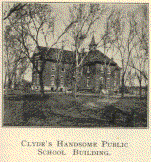 CLYDE'S HANDSOME PUBLIC SCHOOL BUILDING. |
The board of education selected by the Clyde citizens have been particularly efficient. For years during the earlier building up of the schools, David Turner, Sr., was an indefatigable worker for their best interests. Later he was succeeded by James Turner, who followed in his father's footsteps and maintained the same prudent management. W.S. Roach, F.A. Griffin and J.F. Randolph have been capable officers. Since F.A. Griffin's removal from the city his place on the board has been filled by G.G. Goodwin, who will undoubtedly continue the successful co-operation of board, teacher and student that has characterized the past.
Some excellent records have been made in the Clyde schools. Miss Gertrude Wade, who lives at Ames, three miles distant, drove or walked the four years daily that completed her high school course in 1902, and was seldom absent or tardy. Miss Ailsie Morley shows a record of two hundred gained for attendance and punctuality through the entire high school course. Five years prior to 1902, when he graduated, Vernon Morley entered room five, passed through grades seven and eight and into the high school the first year. This young student has not only a retentive memory but wonderful reasoning powers. He studied philosophy as early as 1898, a mere child, and when asked what he wanted to do with it replied, "I want to fix things better in my mind." The class of 1902, not only took what they absolutely needed but adopted zoology and German. Miss Ailsie Morley carried away first honors, and John Van DeMark, second. Of the latter it may be said he gives promise of becoming known in the professional world, being a fine student of superior talents. Milo Ransopher, the little grandson of the late Dr. Ransopher, is a lad of much promise. He shows a particular inclination and talent for mechanical devices and possesses an individuality seldom seen in a boy fifteen years of age. He is never so happy as when "rigged up" in a pair of overalls that reach to the neck, covering his well groomed attire, and studying the intricaces of machinery in the mill or the waterworks. He stands at the head of his class in practical engineering and can manipulate an engine better than many so-called engineers.
When the day arrived for determining whether or not Clyde should have a high school, several young men and boys were largely instrumental in carrying it to a successful conclusion. John Van DeMark, Everard Kinch, Llewellyn Reid, Martin Van DeMark, Raymond Gregg, Charles Montgomery and Cornelius Murphy worked diligently throughout the day, bringing citizens out in carriages to vote on the high school question. They brought out every available voter and kept tally that none should fall to cast a ballot.
As to deportment, general progress and good morals the Clyde schools stand second to none in Cloud county. An article on the Clyde schools would not be complete without mention of "Janitor Ince," who was a beloved and familiar character for about fifteen years. He was an Englishman by birth and having heard he could secure a homestead in the west, came to Kansas. People took a kindly interest in Mr. Ince, who was an aged musician, and when he was gathered to his "eternal home," where his wife had preceded him several years, his familiar face was missed, as he had become a part of the school building.
June 10, 1885, Clyde witnessed the first delegated body of women ever assembled in Cloud county. It was the occasion of the convention of the Woman's Christain Temperance Union for the purpose of establishing a county organization. Mrs. G.W. Allen enjoyed the honor of being the first president of this convention and impressed every one with her rare executive ability. Mrs. Dr. Dabney performed the duties assigned her as secretary in an able manner.
January 19, 1888, one of the most horrible accidents that ever occurred in Clyde took place. The livery stable of Mr. Brownlee, on Green street, was that night discovered to be on fire. The citizens, with the fire company, were soon on the spot to combat the flames. It was announced that a man was in the burning barn, which statement the crowd was loath to believe, but when corroborated by J.E. Toot, and others, who declared they saw him pass from a stall on the north, across the gangway to the south side, and later on his hands and knees wrapped in flames, all doubt was removed. After the flames were extinguished a ghastly spectacle was presented. In the second stall to the south were found the completely disfigured remains of the unfortunate man. The sad affair was directly chargeable to whiskey, as Mr. Brownlee and some associates were in a state of intoxication, and to their condition is the origin of the fire accredited. Mr. Brownlee entered the burning building, ostensibly for the purpose of saving some of his stock. Had he been sober, in all probability he would have been more cautious and his life spared. Twenty horses and two cows were burned with the stable.
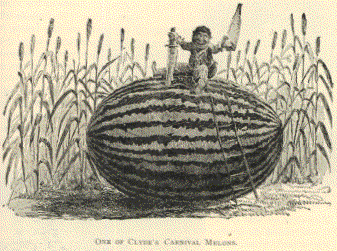
ONE OF CLYDE'S CARNIVAL MELONS.
In the summer of 1899, Clyde held its first watermelon carnival, and there was said to be upwards of fifteen thousand people in attendance. This annual fete is a brilliant success and is a part of the modern history of the city of Clyde. Although the town is full to overflowing with visitors from various towns, they are all cared for, nearly every family entertaining from four to a dozen guests. It is a jolly, good natured crowd. True, there are some "toughs" who take advantage of such a time, and imbibe too much of "the joyful" and become hilarious, but upon the whole, pleasure and innocent sports reign supreme. The portals of the city are thrown wide open and everybody hailing left cares and grievances at home, enters into the spirit of the occasion. The gayety of the crowd is infections and every one becomes oblivious to everything but the laughing, merry-making crew.
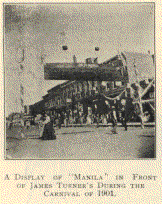 A DISPLAY OF "MANILA" IN FRONT OF JAMES TURNER'S DURING THE CARNIVAL OF 1901. |
Then there is always vaudeville, dancing, racing, baloon ascensions and Clyde's Military band boys who add greatly to the pleasure of the carnival. Melons on all occasions - but the one of the present year - have been free as the waters that flow. Great, luscious melons, as only can be grown in the vicinity of Clyde. Every train is full to overflowing. The watermelon carnival is such a pronounced success it will undoubtedly be a permanent feature in Clyde as the Mardi Gras of New Orleans, the Veiled Prophet of St. Louis or the Priest of Pallas of Kansas City. The whole city is decorated. At the park are long tables, fairly groaning with the weight of huge melons which keep several men continuously carving, and placing on the tables where every one may eat without price.
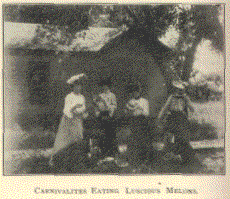 CARNIVALITES EATING LUSCIOUS MELONS. |
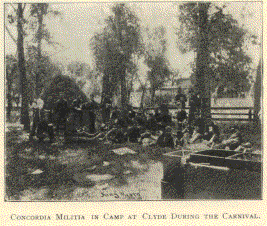
CONCORDIA MILITIA IN CAMP AT CLYDE DURING THE CARNIVAL. |
The carnival of 1902 was not so preeminently a success as on previous years, owing, to the almost total failure of the watermelon crop. However, there were thousands of visitors present and Clyde did royally in entertaining them. The keys of the city were handed over to the merry throng of people that poured off from every incoming train. There were pleasing attractions; among the most engaging perhaps was the battle of Manila, a spectacular illustration of that event which entertained thousands of carnivalites. There were three games of base ball between the Fort Rileys and Topeka Business College, the latter carrying off the honors of the field. One of the special features of the occasion was the flower parade. While not many carriages were included, in point of artistic merit they were exceptionally well executed. This procession was marshaled by J.E. Toot and Dr. C.P. Gillespie, whose military hearing as they cantered here and there mounted on their caparisoned steeds was the envy of all the small boys of soldierly aspirations. The march was preceded by the Military Band. The honor of Queen of the Carnival was worthily bestowed upon Miss Flossie Lowers. Her carriage, beautifully decorated, was drawn by a tandem team and attended by a company of militia. Mrs. E. Peck, whose carriage justly won the first prize, occupied an open vehicle, literally covered with large white roses, a creation of art. She drove a great black, highstepping steed whose arched neck and proud bearing seemed to invite special attention from the lookers to his pretty bonnet of white and gold; his cream white harness, bedecked with white roses, and last but not least his gilded hoofs, a finishing touch that harmonized with his well groomed and shining coat. The carriage of the Misses Farnsworh and Wickwerth won the second prize. This turnout was particularly handsome and won much commendation. The carriages were all designed in a manner to call forth praise and admiration. Mrs. B. Arten's chariot, drawn by three white horses, merited and received much creditable comment. There were many pretty and artistic window decorations, among these, the postoffice book store windows of Sidney H. Knapp, the handiwork of Eugene B. Frankforther, were awarded first prize. They were bedecked with vari-colored crepe paper and all the wares incident to their stock of goods, eliciting much deserved admiration. Sohlinger Brothers' windows were unique; in one was a huge horn suspended midway from the ceiling and the inscription, "Come in and blow yourself." The front of Miss Hay's feed store was among the best, considering her stock in trade and her material for decorating. She was entitled to a prize.
The flourishing city of Clyde is situated on the north bank of the Republican river and on the east bank of Elk creek, which empties into the river at this point. The present population of Clyde is about fourteen hundred people. There are five churches, a magnificent brick school building and about five miles of paved walks. Clyde is "the home of the luscious watermelon." Three lines of railroads pass through the city, the Rock Island, Missouri Pacific and the Union Pacific, rendering it a fine shipping point for stock and grain. As to citizens, a more enterprising, industrious, generous and intelligent class of people (who all pull together for the best interests of their town) does not exist in the state. The substantial business structures, and handsome residences all witness the prosperity of this beautiful little city.
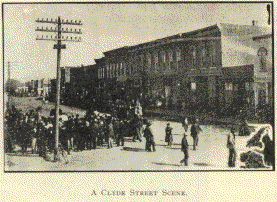
A CLYDE STREET SCENE.
Clyde is situated in one of the finest grain-growing districts on the continent. It is conceded that good crops of corn are grown in the Republican Valley when that industry falls in most other localities. The valley has many natural attractions, is in a high state of cultivation, and unsurpassed for its beauty and richness of soil. Potter's clay is found in abundance in the vicinity of Clyde and in the early days was utilized in the manufacture of pottery. The ware was said to be of excellent quality and the industry was well supported for years, supplying a trade covering many miles with their earthenware. The Clyde Pottery was owned and operated by the Sohlinger Brothers, both of whom are still residents of the county. All the social orders are represented in Clyde. The people are made cognizant with the doings in their town and the outside world by the three papers published in their midst. The Herald, edited by John B. Rupe, who for more than a quarter of a century has had Clyde's best interests very near his heart. The Voice, by Joseph J. Henley, who is also an old timer and devoted to the town of his choice. The Republican, edited by W.A. Huff, is a live paper that is gaining rapidly in popularity. The Clyde Exchange Bank, and the Elk State Bank are solid financial institutions. Clyde's Military Band is the pride of her citizens, and justly so, for it stands at the head of all organizations of its kind in the county. Every line of business is represented and many of them are metropolitan in their appointments.
The Elk State Bank, one of the solid institutions of Clyde, was established under the present management in 1897, with a capital stock of ten thousand dollars. The officers were N.D. Sprague, of New York, president; Charles E. Clark, of Buffalo, vice-president; W.H. Howard, cashier. Directors, N.D. Sprague, Charles E. Clark, W.H. Howard, C.F. Armstrong, R.H. Gill, W.L. Brandon and C.H. Brosseau; the last four named are citizens of Clyde. In March, 1899, D.H. Atwood was elected cashier and the bank is practically under his management. In December, 1901, the capital stock was increased to fifteen thousand dollars. The present officials are C.F. Armstrong, president; R.H. Gill, vice-president; D.H. Atwood, cashier. Directors, C.F. Armstrong, R.H. Gill, R.B. Miller, F.H. Butler, W.L. Brandon, G.L. Gregg and F.J. Atwood. The present organization are all local men. The building occupied by the Elk State Bank was built by the Van DeMark brothers in 1880.
The Elk State Bank was incorporated under the name of State Bank of Clyde, in 1880, by the Van DeMark brothers, with M.V.B. Van DeMark, president and Charles W. Van DeMark, cashier. This bank was sold in June, 1886, and the name changed to the Elk State Bank of Clyde. In 1882, W.P. Rice came to Clyde for the purpose of starting a bank. A friend offered to furnish fifty thousand dollars with the proviso that a son, who was a wayward fellow, be taken in and taught the banking business. The son grew tired very shortly afterward and returned to his home in the east, but the capital was forthcoming and the Clyde State Bank was established. Then, money was two per cent and notes ten and fifteen per cent, per month. A few years later the institution was changed and put under the supervision of the First National Bank of Clyde, with a capital stock of fifty thousand dollars. A few years later the Republican Valley Bank was organized as a State bank, with a capital of twenty-five thousand dollars, with N.B. Nutt, president, who bought the stock. After an existence of two years, this bank went under during the panic. A few years prior the Clyde Banking Company did business in the same building with S.F. Robinson in charge. It closed up its affairs about the same time the Republican Valley Bank failed. F.H. Butler was appointed receiver and wound up the business.
W. P. Rice was an interesting character and made considerable history. He was superintendent of the United States Prison prior to coming to Clyde. He organized banks at Ames, Cuba, Washington and Greenleaf and helped to boom these towns. He was a man of resourceful energy and about this time went to the State of Vermont, where he raised one million two hundred and fifty thousand dollars, establishing a National Bank and left Clyde to assume the management. Within the next few months he interested himself at Ft. Payne, Alabama, where he instigated a boom which amounted to thousands of dollars of capital. Mr. Rice at this time was rated at eight hundred thousand dollars and lost it all when the "bubble bursted" at Ft. Payne. He was practically broke for about eight years, losing his reputation, his influence and his capital; but this energetic rustler was not to be kept down and was soon associated with eastern capitalists who recognized his ability as a promoter of trusts, and sent him to London to sell stock for them. He was successful as a promotor and has again arisen to affluence and influence, being rated at about two million dollars. Mr. Rice was perhaps one of the most distinguished citizens Clyde has ever had.
![]()
Transcribed from E.F. Hollibaugh's Biographical history of Cloud County, Kansas biographies of representative citizens. Illustrated with portraits of prominent people, cuts of homes, stock, etc. [n.p., 1903] 919p. illus., ports. 28 cm.
New Index
A | B | C | D | E | F | G | H | I | J | K | L | M | N | O | P | Q | R | S | T | U | V | W | Y | Z
